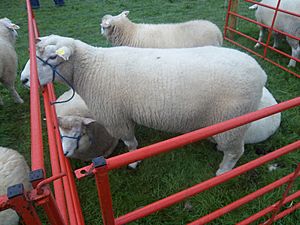Galway sheep facts for kids
The Galway is a special type of domestic sheep that comes from Galway, a place in the west of Ireland. These sheep are quite large. They have a white face and don't have horns. You can often spot them by the fluffy wool on their heads and legs. Their lips are usually dark, and they might have dark spots on their ears.
Galway sheep are mostly raised for their meat. On average, a mother Galway sheep has about 1 to 2 lambs at a time. Most adult female Galway sheep weigh around 80 to 85 kilograms (about 176 to 187 pounds).
History of the Galway Sheep
The Galway sheep breed was developed in the west of Ireland. This happened because English Longwool sheep were brought to Ireland starting in the late 1600s. In the mid-1700s, a famous sheep breeder named Robert Bakewell exported many of his improved Leicester sheep to Ireland. These sheep were sent to places like Lord Roscommon's estate.
For many years, the sheep that developed from these imports were known as the Roscommon breed. A special book for Roscommon Long-Wool Sheep was even started in 1895. The Roscommon was a large, white-faced sheep without horns. It looked a lot like Bakewell's original sheep.
Founding the Galway Sheep Breeders Society
By 1923, the Roscommon breed society was not doing well. So, a group of sheep breeders in Galway decided to start their own group. They called it the Galway Sheep Breeders Society. They checked over 6,000 female sheep and 200 male sheep. Only about 10% of these were chosen for the new Galway sheep register. This selection likely helped create a slightly neater type of sheep than the old Roscommon.
Galway Sheep Today
Many people claim that the Galway is Ireland's only native sheep breed. However, there were other types of sheep in Ireland long ago, and some believe mountain sheep should also be recognized as native.
In 1990, there were only 14 breeders of true Galway sheep. By 1999, this number had grown to 39 breeders, with less than 1,000 true Galway sheep. Almost all of these breeders live west of the River Shannon in Ireland.
The Irish government helps protect the Galway breed. Breeders in Ireland can get extra payments to help keep the breed going. There are also a few hundred Galway sheep in the United Kingdom.


